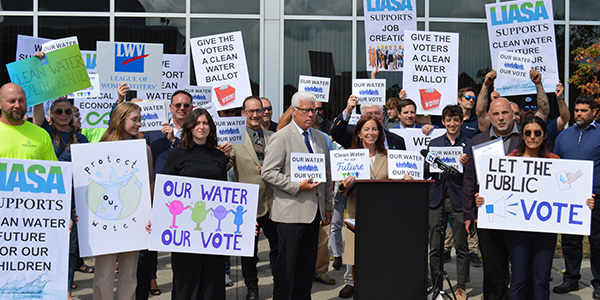
Suffolk County does not have a septic problem. It has 380,000 septic problems.
This is not news. County residents have known about it for decades, as has the Suffolk County Legislature. In the first paragraph of the Introduction to its Executive Summary of its Comprehensive Water Resources Management Plan, issued in January 2014, the legislature acknowledges “Suffolk County’s water quality is at a tipping point.” One paragraph later, it identifies the source of the problem: “Nitrogen, which primarily spews from residential septics and cesspools, as well as fertilizer, are the principal culprits.” That was nearly a decade ago.
What is new this summer is a pathway to addressing the nitrogen pollution caused by all those outdated or inadequate septic systems: the proposed Suffolk County Water Quality Restoration Act, which would create a dedicated source of funding to connect homes and businesses to sewer systems where possible and replace those failing systems with clean water septic systems.
The initial source of the funding would be a tiny increase to the county sales tax: .125%. That’s 1/8 of a penny for every dollar spent. You make an $8 purchase, that’s a penny for the fund. Make an $800 purchase, that’s a dollar. All those partial pennies will add up, but they have even more collective power than that.
Those funds are the key to unlocking unprecedented matching funds from New York State and the federal government. Federal infrastructure grants could provide 90% of the funding for the first two years of those projects that are a solution to the nitrogen pollution, then 80% thereafter. If you have a $10 problem and someone is going to give you $9 to help you get it done, that seems like a pretty good deal.
It has never been easier to access critical funding than it is today. The Suffolk County Legislature needs to get in line for that federal infrastructure green.
Which brings us to the one real problem that threatens to exacerbate the environmental damage caused by those 380,000 other ones.
The Suffolk County Legislature appears to be disinclined to take advantage of what most people in political and environmental circles recognize as a once-in-a-generation opportunity to invest in clean water infrastructure. At its meeting on June 21, the Legislature voted 10-6 along party lines to recess rather than close the public hearing on IR 1512 (which would consolidate the county’s 27 sewer districts) and IR 1573 (which would establish the new Water Quality Restoration Fund). The hearing must be closed in order for the Legislature could vote on whether to allow the public to vote on these two proposals. The deadline to get them on the November ballot is August 4; no vote by the legislators means no opportunity for their constituents to vote. These are the same constituents who voted to support the $4.2 billion Environmental Bond Act at a nearly 2-to-1 ratio, and who have historically supported clean water initiatives.
It’s difficult for the wheels of progress to turn with a stick in their spokes.
Fortunately, there is one more chance for the Legislature to close the public hearing, adopt both laws, and let the voters of Suffolk County decide the course of their clean water future. The Legislature is scheduled to meet on Tuesday, July 25, at the William H. Rogers Building (725 Veterans Memorial Highway, Smithtown). A public hearing is set for 2:30 p.m.

At the last public hearing, David Ansel, our vice president of water protection, was the first of approximately 50 speakers to address the legislature. He is planning to testify at the hearing on the 25th, along with other leaders from environmental, labor, and business groups.
But there is one more voice to be added to the chorus of support: yours.
If Suffolk County voters want to have an opportunity at the ballot box in November, they should attend next Tuesday’s public hearing. Perhaps even consider testifying. At the very least, your presence will be noted: packed rooms can be highly persuasive. And this is the last chance to demonstrate to your elected officials that clean water is your priority, and that it should be theirs.
If they don’t act now, other counties and municipalities will get on line for that federal funding. Ahead of Suffolk County. The cost of additional delay would be devastating.
“There are two things to think about in terms of what a lost opportunity it would be,” said David. “There’s the environmental cost. Long Island Sound and the waterways on and around Long Island will continue to be polluted with nitrogen. We’ll be wasting time we don’t have to solve a problem that’s only getting worse because of climate change. Then there’s the risk of losing out on the funding. Suffolk County will be putting itself in a precarious position if it waits too long. Other communities are going to get that money.”
